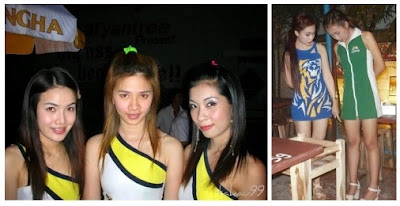(Note: in Singapore, besides their consultation fees, doctors make money from selling medicine as well as they usually stock them in their clinics. This is one of the reasons why medicine in Singapore is expensive).
Pharmacies
A pharmacy is known as ‘raan khai yaa’, which means ‘shop that sells medicine’. Except in the rural areas, you can find a pharmacy in practically every shopping mall or in the neighbourhood all over Thailand. Pharmacies in shopping malls include Boots, Watsons, and independent stores while those in the neighbourhood have a mom-and-pop setup.
Store Setup
Most pharmacies in Thailand look the same; a glass enclosed store front, glass counters in the store, and glass cabinets (or shelves) on the walls. The sign used to indicate the pharmacy is placed outside the store and is usually depicted with:
- The word for medicine written in Thai (see pic).
- A white background with a cross in another colour (e.g. red, blue, green etc).
The Pharmacist
Most, if not all, of the pharmacists in the shopping malls speak English and will be able to give you advice on the medication that you need or are looking for. Those in the neighbourhood stores typically cannot speak English. Though they may know the names of the various drugs, the differences in the way Thais and other English speakers pronounce these names often make it hard for them to understand what you are looking for. Therefore, it is often helpful to show them a picture of the drug you need on your phone.
Medications Available
The types of medicine that you can buy over the counter include:
Antibiotics
In Singapore, antibiotics have to be prescribed by the doctor and cannot be bought at a pharmacy. In Thailand, you can buy several types of antibiotics over the counter, e.g. erythromycin, amoxicillin, doxycycline etc.
Antibiotics are known as ‘yaa khaa cheua’ in Thai, meaning ‘bacteria killing medicine’. Many uninformed Thais think that antibiotics are a cure all for various ailments; for example, if you have a sore throat – take antibiotics. If you have diarrhoea – take antibiotics. This can be dangerous as such misuse can create bacterial resistance to antibiotics in our bodies.
Birth Control Pills
Again, in Singapore, birth control pills have to be prescribed by a doctor. In Thailand, you can buy various brands of birth control pills, both local international, at the pharmacy. A month’s supply will cost you roughly just a few hundred baht.
Cough & Cold Medicines
You can buy paracetemol marketed under various Thai brands (e.g. Sara, Tiffy etc) and Decolgen for colds.
Various Ointments & Creams
You can get a wide range of these, from antihistamines to steroid creams.
Brand Name Drugs vs Generics
The generics of many well-known drugs can be bought in Thailand. They are marketed under different brand names here and are usually much cheaper than the brand name drugs - due to government price controls and the fact that many are produced locally (possible due to expired patents).
You can find out the name of these generics with a little research online. Storing a picture of it in your phone for showing it to the pharmacist will make it easier for him to find you what you are looking for.
Other Sources
If you cannot find what you want outside, you can go to the doctor at a hospital for a prescription as or try the pharmacies located there. But note that drugs prices here are usually higher as compared to outside stores and it is common for them to provide only brand name medications.
Drugs Safety and Efficacy
Generally, drugs in Thailand are genuine and will work as they should. This is true even if you had purchased them from the small neighbourhood shops. However, complaints about fake drugs or inefficacious drugs sometimes do occur but could be partly due to improper storage of the drugs (i.e. not storing them in a cool, dry place, exposing them to heat and humidity), causing them to spoil or deteriorate.
If you are concerned about drug safety, buy only from the well-known pharmacies or those located in the shopping malls. Be sure to check the expiry date of the drugs and store the medication (especially ointments and creams) in the refrigerator if necessary.
Controlled Drugs
While you can get a wide range of drugs at the pharmacy, certain drugs that are considered dangerous, e.g. morphine, are regulated more strictly and may be more difficult to find here.
Thailand takes a hardline stance on drugs. Contrary to what many people think, you cannot buy your way out of every trouble in Thailand; not every policeman can be bought (you might even end up with a bribery charge against you in the process), or they may simply take your money and put you away anyway. Many foreigners have been put in prison for drug trafficking and even for recreational drug use. So do not abuse drugs and stay far away from people and places that you know drugs are present.
If you have a condition that requires you to take controlled medication, make sure that you have the original prescription bottle and doctor’s prescription/documentation with you when you are travelling abroad. Having these on hand will save you a lot of trouble with government officials should they find these controlled drugs on you and they start asking questions.

















